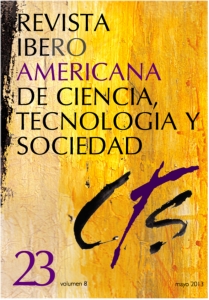Three problems concerning Living Labs
A European point of view
DOI:
https://doi.org/10.52712/issn.1850-0013-653Keywords:
citizen laboratories, universal innovation systems, cities-laboratories, design scienceAbstract
After a first wave of Living Labs, these new open innovation ecosystems seem to face a set a new problems for its evolution: What is the role of living labs/citizens labs in the overall innovation systems? Is it possible to envision its escalability and universalization? How will they adapt to different countries and cultures? Secondly: How should living labs relate to the new role played by cities in the new innovation systems? In particular, what should be the place of living labs within the context of the so-called “smart cities”? And finally: could living labs be the ground for a new area of research and innovation area? What kind of new professional opportunities will develop from this new scenario?
Downloads
References
ALMIRALL, E. y WAREHAM, J. (2008): “Living Labs and open innovation: Roles and applicability”, eJov: The Electronic Journal for Virtual Organizations and Networks, vol. 10, nº 3, pp. 21-46. Disponible en: http://www.ejov.org/apps/pub.asp?Q=2993&T= eJOV Issues.
ARNKIL, R. (2010), “Exploring Quadruple Helix. Outlining user-oriented innovation models”, University of Tampere, Work Research Center, Working Paper Nº 85. Disponible en: www.cliqproject.eu/.
CHESBROUGH, H. W. (2003). Open Innovation: The new imperative for creating and profiting from technology, Boston, Harvard Business School Press.
ERIKSON, M.; NIITAMO, V. P. y KULKII, S. (2005): “State-of-the-art in utilizing Living Labs approach to user-centric ICT innovation-a European approach”. Disponible en: www.vinnova.se/upload/.../tita/stateoftheart_livinglabs_eriksson2005.pdf.
FORAY, D. (2011): “Smart Specialization, from Research idea to Political Concept”. MTEI Working Paper. Disponible en: https://community.oecd.org/servlet/JiveServlet/ previewBody/33875-102-1-64377/MTEI-WP-2011-001-Foray_David_Hall.pdf.
GINER, S. (s/f): Revolución sin revolución. Disponible en: www.a16-01.com/pdfs/CAU /1972/CAU720501065.pdf.
VON HIPPEL, E. (1986): “Lead users: a source of novel product concepts”. Management”, Science, vol. 32, pp. 791–805. Disponible en: http://mansci.journal. informs.org/content/32/7/791.abstract?ijkey=852d5a337dfd7088f66c5d233230f669d1 8059d0&keytype2=tf_ipsecsha.
LYDON, M. (2010): Tactical Urbanism (vol. 1).
NIITAMO, V. P.; KULKKI, S.; ERIKSSON, M. y HRIBERNIK, K. A. (2006): “State-of- the-art and good practice in the field of Living Labs”, Proceedings of the 12th International Conference on Concurrent Enterprising: Innovative Products and Services through Collaborative Networks, Milan, Italy, 2006, pp. 349-357. Disponible en: http://www.mendeley.com/catalog/state-art-good-practice-field-living-labs-2/.
KAIVO-OJA, J. (2011): Futures of Innovation Systems and Systematic Innovation Systems: Towards Better Innovation Quality with New Innovation Management Tools. E-book 9/2011, Turku, Futures Research Centre. Disponible en: www.utu.fi/fi/yksikot/ffrc/julkaisut/e-tutu/Documents/eTutu_2011_8.pdf.
SERRA, A. (2010): “Citilabs, Qué pueden ser los laboratorios ciudadanos”, La Factoría, nº 45-46. Disponible en: www.revistalafactoria.eu/articulo.php?id=523.
SIMON, H. A. (1969): The sciences of the artificial, Cambridge, MIT press.
TOWNSEND, A. (2011): The Therapeutic City. Disponible en: http://www.anthonymobile.com/2011/02/new-essay-on-therapeutic-cities/.
TORRES, R. (2009): Age is not a barrier: Seniorlab, an Innovative Project-based Approach to Learning for Senior Citizens.
EDULEARN09 (2009): 1st International Conference on Education and New Learning Technologies, Barcelona. Disponible en: http://library.iated.org/view/TORRESKOMPEN2009AGE.
Downloads
Published
How to Cite
Issue
Section
License
Copyright (c) 2024 CC Attribution 4.0

This work is licensed under a Creative Commons Attribution 4.0 International License.
All CTS's issues and academic articles are under a CC-BY license.
Since 2007, CTS has provided open and free access to all its contents, including the complete archive of its quarterly edition and the different products presented in its electronic platform. This decision is based on the belief that offering free access to published materials helps to build a greater and better exchange of knowledge.
In turn, for the quarterly edition, CTS allows institutional and thematic repositories, as well as personal web pages, to self-archive articles in their post-print or editorial version, immediately after the publication of the final version of each issue and under the condition that a link to the original source will be incorporated into the self-archive.











